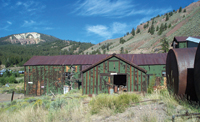Reclamation of hazardous mine tailings is beginning this week at Livingston Mill, a historic mining operation on the east slope of the White Cloud Mountains of Central Idaho.
The mill site is on Big Boulder Creek, in the East Fork of the Salmon River on the Sawtooth National Recreation Area near Clayton.
The tailings, composed of soil and rocks left over from mining, are being gathered and confined to reduce environmental contamination. They contain elevated levels of heavy metals, particularly lead and arsenic.
"A screening level human health and ecological risk assessment indicated significant risks to human and ecological receptor(s) at the site," stated a June 2006 Engineering Evaluation/Cost Analysis written by Millennium Science and Engineering and adopted by the U.S. Forest Service.
The Forest Service said the public health risk from airborne contaminants during the reclamation will be minimal, although anyone using the trailhead or the Railroad Ridge road should avoid breathing dust or drinking water in the project area.
The majority of the reclamation work is expected to be completed by the end of July.
The project area is immediately adjacent to the Livingston Mill Trailhead, one of the primary access points into the east side of the White Cloud Mountains. The trailhead will remain open only for hiking access during reclamation, though users might experience some delays necessary for public safety.
Camping will not be allowed in the trailhead or elsewhere in the project area for the duration of the project and parking will be allowed only at the trailhead. The Railroad Ridge road will, if possible, remain open for public travel, though some delays will be inevitable.
"There will be a lot of heavy equipment working in the area that could pose some safety hazards," said Forest Service project manager Pat Trainor.
Trainor said that every effort will be made to provide safe access to the area.
The Livingston Mill site processed ore from the Livingston Mine, located four miles west of the mill site. The mine operated from the late 1800s to the 1950s and produced primarily lead, zinc, and silver. The mill site is still an active claim although currently no ore is being processed there. The tailings will be buried and covered with an impermeable liner, then capped with topsoil and planted with native seeds.
The 58-page Engineering Evaluation/Cost Analysis, procured by the Idaho Mountain Express through a Freedom of Information Act request in January, detailed contamination at the site and set out four cleanup alternatives that ranged from "no action" to complete removal of the tailings. This summer's $1.2 million cleanup is the most exhaustive and expensive of the options proposed.
"The primary risk to human health at the site is from exposure to arsenic and lead in the mine tailings at (two of the tailings deposits) and contaminated soils around (one of the mills)," the document states.
The document says arsenic concentrations exceed risk criteria at "extremely high risk levels," and lead concentrations exceed risk criteria at "moderate to high risk levels." Also present are copper, zinc and selenium, as well as cyanide used in the milling process.
Trainor said in a January interview that the most significant risk to human health is probably caused by wind-borne dust particles that could be inhaled by people in the area.
"Every contaminant has what we call a pathway," Trainor said. "Inhalation is the biggest factor. When it gets into your lungs, obviously it's absorbed into the blood and your system more rapidly than if it's on your skin."
Lead is a highly toxic metal, particularly harmful to children and unborn babies. In adults, according to the Environmental Protection Agency, it can cause difficulties during pregnancy and trigger high blood pressure, digestive problems, nerve disorders, memory problems and muscle pain.
Arsenic is a toxic heavy metal that can cause headaches, confusion, sleepiness and convulsions. It can also cause vomiting, diarrhea and kidney, liver and lung problems. In extreme cases arsenic poisoning can result in death.
In the words of the Sawtooth National Forest in an online project summary: "This is a very large cleanup project" that involves treatment of approximately 60,000 tons of tailings.
SNRA Backcountry Recreation Manager Ed Cannady encouraged those wishing to access the White Clouds to use the Little Boulder Creek Trail access if possible.
"A lot of folks who are headed to Frog Lake and the Boulder Chain Lakes come in from Livingston Mill, but this is a good time to try a new route," Cannady said. "It's at least as scenic and similar in difficulty.
"Livingston Mill Trailhead provides the only access to upper Big Boulder Creek, and we want to maintain that access, but for other destinations it is probably better to use Little Boulder."
The Little Boulder Trailhead is on the East Fork Salmon River road 1.8 miles past the Big Boulder road turnoff.
The contractor on the project is Jay R. Thornton Construction, of Malta, Idaho.


 An old mill facility at Livingston Mill on the east slope of the White Cloud Mountains is a relic from the regionís silver-mining history.
Photo courtesy U.S. Forest Service
An old mill facility at Livingston Mill on the east slope of the White Cloud Mountains is a relic from the regionís silver-mining history.
Photo courtesy U.S. Forest Service



































